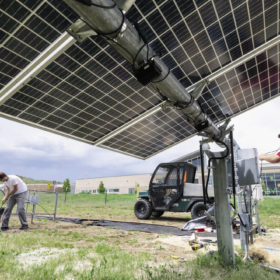System operators are getting more flexible
Distribution system operators have their work cut out for them, as they are tasked with the ever-increasing challenge of managing their networks at times of increasing EV penetration, the electrification of heat, and distributed behind-the-meter generation and storage. As transmission system operator markets have opened to demand-side flexibility across Europe and beyond, we now see a trend of DSOs at the very early stages of a similar transition, writes Philippa Hardy, principal analyst at Delta-EE. DSOs are now starting to call on behind-the-meter assets to support local network management and balancing. This provides cost savings for DSOs, while offering opportunities for DSF providers and asset owners.
Reducing solar’s environmental impact through ecolabels
It is undeniable that easy access to energy has provided tremendous benefits to humankind over the last several decades. But that access has come at a price – one that society only discovered after the fact. From the thousand-year half-lives of spent nuclear fuel to the climate change impact of fossil fuels, access to energy has had a high environmental cost. Renewable energy, especially solar, seeks to provide that same access without the environmental cost. But what is the environmental impact of solar panels and inverters? Is society once again seeking to benefit from an energy source without understanding and addressing its environmental impact? Not this time, writes Green Electronics Council CEO Nancy Gillis.
Bigger and better: Technology
The SNEC 2020 PV Power Expo opened on Aug. 8 in Shanghai. Unlike previous editions, the world’s largest solar trade fair was mostly attended by Chinese participants this year due to the Covid-19 pandemic. While the trade fair used to offer insights into global market trends, volumes were low this year due to a buyer/seller standoff amid rising prices caused by the recent accidents at polysilicon plants in Xinjiang. Also, there was little change in technologies. PV InfoLink’s Corrine Lin offers insights into cells and modules at SNEC 2020.
Texas will outshine California in 2020
The Covid-19 pandemic continues to cast a cloud on industries around the world, but the U.S. utility-scale solar segment is still growing, writes IHS Markit solar analyst Maria J. Chea. Around 3 GW of solar PV is set to be installed this year in Texas alone, but opportunities also abound across several other southern U.S. states.
Qatar’s national solarized fintech strategy
The State of Qatar is a World Bank high-income economy, backed by the world’s third-largest natural gas and oil reserves. Qatar has the third-highest GDP per capita in the world, with very high human development. Similar to other Gulf Cooperation Council states – the United Arab Emirates, Saudi Arabia, Qatar, Oman, Kuwait and Bahrain – Qatar is wrestling with the fluctuations in global hydrocarbons prices that started in 2014 and are now compounded by the Saudi-led embargo since 2017.
Consolidation continues for polysilicon makers
While mono-grade polysilicon prices did not decrease much in the first quarter owing to stable demand, multi-grade fell to record lows as its market share diminished. During the second quarter, writes PV InfoLink senior analyst Cooper Chen, the market saw excessive supply. Monocrystalline manufacturers have been running at full tilt and bringing new capacities online as scheduled, while the pandemic rages on overseas.
Bifacial modules: The challenges and advantages
Bifacial modules are one of the older developments in solar panel technology, dating back to the 1960s. It is also one of the latest advances to take hold. According to many experts, however, it is now on track as the latest trend to sweep the solar industry and will soon become the standard.
The ‘rubber-band effect’ on renewable energy project margins
David Riester of Lacuna Sustainable Investments, looks at how, on the journey from concept to monetized power plant, renewables and energy storage projects tend to get tugged toward ‘zero’ margin, from either direction. The further the rubber band is stretched, the stronger the pull back toward zero.
Energy storage and network reinforcement
As renewables penetration increases, transmission and distribution (T&D) infrastructure will require significant reinforcement. Battery storage is becoming a key alternative to traditional ways of reinforcing network infrastructure, because it is fast to deploy, can provide multiple services, and often comes at a lower capital cost. IHS Markit analyst Oliver Forsyth delves into the additional value streams that strengthen the case for grid-connected batteries.
All details of Ukraine’s new feed-in tariffs for PV
On July 21, 2020, the Law on Feed-in Tariff Restructuring was passed by the Verkhovna Rada of Ukraine.









